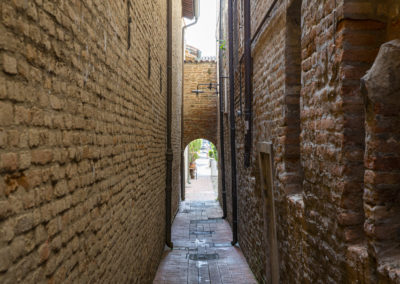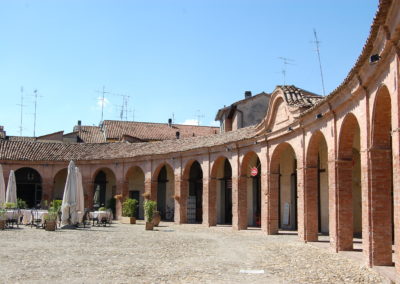Bagnacavallo is one of the most interesting towns of the province; its name is thought to originate from a hypothetical spa whose water healed the horse of the Roman emperor Tiberius.
The town centre is well preserved, with its Medieval irregular structure, scenographical arcades and a wide number of palaces and religious buildings.
Overlooking the main piazza della Libertà are the Neoclassical Town hall, designed by Cosimo Morelli and built from 1791, and the Teatro Goldoni, opened in 1845. On the western side of the square there are more civic buildings: Palazzo Vecchio (originally from the XIII century) and the Civic Tower (mid XIII century); this used to be a jail and in 1849 housed the famous bandit “Il Passatore”. The Church of Suffragio (XVII century) and the public subway Old Gallery are next to the square, in via Trento Trieste.
Via Mazzini features various interesting buildings, amongst which: Palazzo delle Opere Pie, built in 1728; the XVII century church Collegiata di San Michele Arcangelo (with a magnificent altarpiece by Bartolomeo Ramenghi); the elegantly arcaded Palazzo Longanesi Cattani, the Baroque-Neoclassical Church of Carmine, the Lovers’ lane, next to the former monastery of the Carmelites, the Palazzo Abbondanza (1675), which housed the first public theatre of the town, the noble XVII century Palazzo Folicaldi and the town gate Porta Superiore, at the end of via Mazzini.
Along via Garibaldi can be seen the XVIII century Palazzo Gradenigo, the XIII century Tower (Torraccia), the Church and Convent of San Giovanni (XVII century) where Lord Byron’s daughter Allegra died in 1822; right at the end of via Garibaldi there is a town gate named Porta Pieve.
Along the central via Matteotti there is the elegant Palazzo Capra, the XV century stronghold named Castellaccio is in via Baracca, the palaces Liverani and Randi can be seen along the characteristic narrow lane Via Garzoni, the XVIII century Palazzo Graziani and the botanical garden Giardino dei Semplici overlook via Diaz.
The most distinctive building of Bagnacavallo is the unique and elegant arcaded oval square Piazza Nuova, built in 1758 as a market place for the trade of meat, fish and oil. The monastery of San Francesco lies between via De Amicis and via Cadorna; originally built in the XIII century, it was subsequently modified and partly rebuilt in the XVIII century. Recently restored, part of the monastery now houses a hotel; the building has a magnificent cloister and some public spaces, amongst which the beautiful former monks’ dining hall Sala Oriani.
The former Capuchin nuns convent (via Vittorio Veneto) is home to the local museum Museo civico delle Cappuccine, featuring ancient and contemporary art works on display, the public library, an important archive and a large print collection.
The Parish church of San Pietro in Sylvis is just outside Bagnacavallo; this remarkably well preserved VII century building houses important frescoes of the XIV century Riminese school and an interesting crypt.
Not far from the parish lies the natural reserve Podere Pantaleone, with the original flora and fauna of the old local countryside environment. In the village of Villanova di Bagnacavallo, just few km from Bagnacavallo, there is an ethnographic museum named Ecomuseo delle Erbe Palustri preserving and celebrating the traditional local crafts made with marsh plants’ fibres; this includes an open air display (Etnoparco Villanova delle Capanne) showing rural huts made out of local natural fibres and wood.
Main events
From mid-May to early June, the evocative nocturnal guided tours “Di notte tra gufi, lucciole e pipistrelli” (“At night among owls, fireflies and bats”) take place at Podere Pantaleone.
Summer is full of musical and gastronomic events and September hosts the ancient feast Sagra di San Michele (1202) and the Feast of Erbe Palustri (marsh reeds) in Villanova.
Useful info
Where to sleep in Bagnacavallo
Where to eat in Bagnacavallo
For more information, consult the chapter on Bagnacavallo of “Terra del Benvivere – Tourist Guide of the Union of Municipalities of Lower Romagna!” (published in 2010) and the Map (2023)
Weitere Informationen finden Sie im Kapitel über Bagnacavallo von “Terra del Benvivere – Fremdenführer der Union der Gemeinden der unteren Romagna!” (veröffentlicht im Jahr 2010)
HOW TO CONTACT US
Tourist information office
Address: Piazza della Libertà, 13 48012 Bagnacavallo (RA)
Tel: 0545 280898
Fax: 0545 280859
E-mail: turismo@unione.labassaromagna.it
Website: http://www.comune.bagnacavallo.ra.it

By Car
Bagnacavallo is in the province of Ravenna, it is 23km from Ravenna, 20km from Faenza, 56km from Bologna, 65km from Ferrara and about 30km from the Adriatic Sea
Tollgates: Bagnacavallo, on the A14 dir and Faenza on the A 14 (about 12km away)
The town is located at the cross with the main road S.S.253 San Vitale (running from Bologna to Ravenna) and S.P.8 Naviglio
Bus and coach
http://www.startromagna.it/
https://www.tper.it/
Railway
Bagnacavallo is on the Bologna-Ravenna railway line. In Lugo, just 5km away, change for Ferrara and Faenza
Info www.trenitalia.com
Airplane
Bologna airport (65km)
Info www.bologna-airport.it
Rimini airport (70km)
Info www.riminiairport.com









